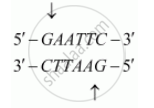Advertisements
Advertisements
प्रश्न
Explain the roles of the following with the help of an example each in recombinant DNA technology :
Restriction Enzymes
उत्तर
Restriction enzymes are specialised enzymes that recognise and cut a particular sequence of DNA. Every restriction enzyme identifies specific sequences called recognition sequences. These recognition sequences are palindromic. Palindromes are the sequence of base pairs that read same both backwards and forwards (i.e., same in 5' → 3' and 3' → 5' direction).
Restriction enzymes are of two types:
1) Restriction endonucleases − They cut the DNA at specific positions within the DNA
2) Restriction exonucleases − They cut the DNA at the ends (remove the nucleotides at the ends of the DNA).
The restriction endonuclease is specifically important and is extensively used in recombinant DNA technology. They are capable of cutting DNA fragment in two ways, resulting in the formation of either blunt or sticky ends. Sticky ends obtained after the action of restriction enzymes are particularly important in recombinant DNA technology as they are helpful in linking the foreign DNA to the vector.
Restriction enzymes cut a little away from the centre of the palindrome site, but between the two bases on opposite strands. For example, restriction enzyme Eco-RI is one such restriction endonuclease that gives sticky ends.

Hence, structures called overhangs (or sticky ends) are generated on each strand. Overhangs are the structures obtained after palindromic sequences are cut by molecular scissors.

They are significant because these sticky ends form hydrogen bonds with their complementary counterparts with the help of DNA ligases.
APPEARS IN
संबंधित प्रश्न
Mention the difference in the mode of action of exonuclease and endonuclease.
Explain briefly:
Restriction enzymes and DNA
Restriction enzymes ______.
There is a restriction endonudease called as EcoRI. What does co part in it stands for?
While isolating DNA from bacteria, which of the following enzymes is not required?
Which of the following statements does not hold true for restriction enzyme?
A plasmid DNA and a linear DNA (both are of the same size) have one site for a restriction endonuclease. When cut and separated on agarose gel electrophoresis, plasmid shows one DNA band while linear DNA shows two fragments. Explain.
CTTAAG
GAATTC
- What are such sequences called? Name the enzyme used that recognizes such nucleotide sequences.
- What is their significance in biotechnology?
What are the protruding and hanging stretches of DNA produced by these restriction enzymes called? Describe their role in the formation of rDNA.
How are DNA fragments visualised once they are separated by gel electrophoresis?
